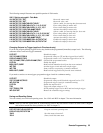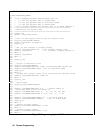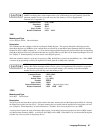
Language Dictionary 61
7
Language Dictionary
Introduction
This section gives the syntax and parameters for all the IEEE 488.2 SCPI commands and the Common commands used by
the Agilent SAS. It is assumed that you are familiar with the material in chapter 6 - Remote Programming. That chapter
explains the terms, symbols, and syntactical structures used here and gives an introduction to programming. You should
also be familiar with chapter 5 - Front Panel Operation in order to understand how the Agilent SAS functions.
The programming examples are simple applications of SCPI commands. Since SCPI syntax remains the same for all
programming languages, the examples are generic.
Syntax definitions use the long form, but only short form headers (or "keywords") appear in the examples. If you have any
concern that the meaning of a header in your program listing will not be obvious at some later time, then use the long form
to help make your program self-documenting.
Parameters
Most commands require a parameter and all queries will return a parameter. The range for a parameter may vary according
to the model of Agilent SAS. Parameters for all models are listed in Table 7-3.
Related Commands
Where appropriate, related commands or queries are included. These are listed either because they are directly related by
function or because reading about them will clarify or enhance your understanding of the original command or query.
Order of Presentation
The dictionary is organized as follows:
l IEEE 488.2 common commands, in alphabetical order.
l Subsystem commands.
Common Commands
Common commands begin with an * and consist of three letters (command) or three letters and a ? (query). Common
commands are defined by the IEEE 488.2 standard to perform some common interface functions. The Agilent SAS
responds to the 13 required common commands that control status reporting, synchronization, and internal operations. The
Agilent SAS also responds to five optional common commands controlling triggers, power-on conditions, and stored
operating parameters.
Subsystem Commands
Subsystem commands are specific to Agilent SAS functions. They can be a single command or a group of commands. The
groups are comprised of commands that extend one or more levels below the root. The description of subsystem commands
follows the listing of the common commands.


















